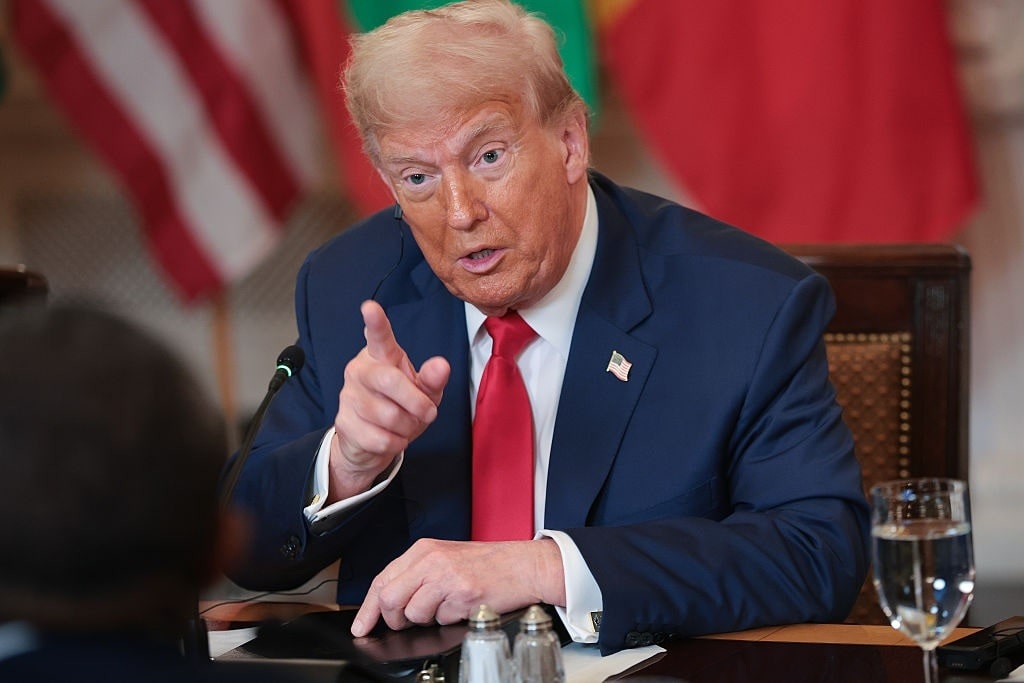
No more Mr. Nice Guy just dealt the Russian leader a tough hand.
In a meeting with NATO Secretary General Mark Rutte on July 14, President Donald Trump made it clear he had had enough of Russian President Vladimir Putin’s stalling and trolling. At the press availability, Trump drew a line in the sand, giving Putin 50 days to come back to the negotiating table in good faith or the United States will levy secondary sanctions on Russia’s ability to do business globally.
Trump Not Happy With Putin
As Trump explained, the Russian leader talks really nicely and then doesn’t follow through. Those days are over, as the commander-in-chief noted:
“But we’re very, very unhappy with [Putin], and we’re going to be doing very severe tariffs if we don’t have a deal in 50 days, tariffs that are about 100 percent. You’d call them secondary tariffs.”
To address his displeasure with the Russians, Trump also announced that the United States would be selling both offensive and defensive weapons to NATO. “Secretary of State Marco Rubio said Friday [July 11] that some of the U.S.-made weapons that Ukraine is seeking are deployed with NATO allies in Europe. Those weapons could be transferred to Ukraine, with European countries buying replacements from the US, he said,” Military Times reported. These systems will help to shoot down the massive drone and cruise-missile assaults the Kremlin has been launching against Ukraine lately. Rutte added that Putin was launching “700 drones a day, missiles, bombing cities. This is not because of military goals. It is just creating panic.”
Political pundits inside the DC beltway have attempted to draw parallels between Trump’s approach to providing weapons to Ukraine and that of the previous administration. According to a RealClear Politics article:
“Unlike Biden, the Trump administration will not send military aid directly to Ukraine. Instead, NATO allies will purchase weapons from the US and then funnel them to the front lines, a development that comes in the weeks after those European nations finally agreed to meet Trump’s separate demand that they spend at least 5% of their annual GDP on defense within the next decade.”
The renewed flow of military aid to Ukraine signals a shift in the level of support the US president is providing to the Kyiv government. “A top ally of Trump, Republican Sen. Lindsey Graham of South Carolina, said Sunday [July 13] that the conflict is nearing an inflection point as Trump shows growing interest in helping Ukraine fight back against Russia’s full-scale invasion,” the Associated Press reported. Previously, Trump had been skeptical that the large amount of military assistance the United States and its allies were giving Ukraine was effective in bringing Putin to the negotiating table to stop the unfettered killing in Russia’s war on Ukraine.
However, it’s not only about pushing more weapons to Kyiv but also combining a resurgence of offensive and defensive weapons with financially punishing secondary tariffs. According to the Stockholm International Peace Research Institute, Russia is spending 40% of its total government budget on defense, most of which goes to replenish weapons and equipment lost in Ukraine. Over the long term, such spending is unsustainable in light of other domestic priorities.
Kremlin Cannot Support War in Ukraine Much Longer
It’s unclear how long the Kremlin can support this level of spending if progress toward a ceasefire and lasting peace is not forthcoming within 50 days. Trump will implement secondary sanctions on those doing business with Russia — legislation to do just that is making its way through the Senate. Sens. Lindsey Graham (R-SC) and Richard Blumenthal (D-CT), along with 81 bipartisan co-sponsors, are pushing a bill called the Sanctioning Russia Act of 2025 (S.124/H.R2548). The 83 senators in favor make the bill filibuster-proof, having more than 60 votes. The legislation proposes 500% tariffs on countries such as Brazil, which buys 12% of its oil products from Russia; India, which acquires 38% of its crude oil imports from Russia; and China, which gets 47% of its petroleum from Russia. The Kremlin’s energy revenue flow could be significantly disrupted. The tariffs on these countries would be a powerful motivation to find alternative sources for oil, and the loss of revenue would push Russia further down an economic slide.
Trump is demonstrating that economic warfare may be the most effective weapon to get Russia to come to the bargaining table. In the midst of renegotiating economic agreements worldwide, Trump is well-positioned to coordinate tariffs and bilateral trade agreements, thereby exerting geopolitical pressure where it will have the greatest impact for the United States. The whole world is the playing field, but the objective is to achieve a ceasefire in Ukraine.
The views expressed are those of the author and not of any other affiliate.
Liberty Nation does not endorse candidates, campaigns, or legislation, and this presentation is no endorsement.

















